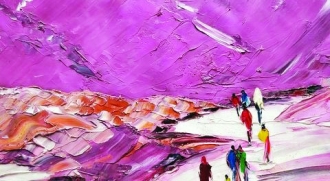The reporter Divya Giri says, the Afghan art exhibition highlights how hope continues to thrive regardless of violence in the country.
I have seen so much bloodshed, I think the stories would fill a book,” says Mohammad Salim Attaie from Kabul, a self-taught artist. Currently in India, Attaie is leading a group of artists from Afghanistan including Abdul Fatah Amar; Mohammad Azim Rawofi and Mohibullah Attaie (Moheb Sadiq) for the exhibition, Afghan Art: A Land in Conflict and Hope.
Attaie and his fellow artists have not had it easy and practiced their craft despite what was happening in their country. The war that ravaged Afghanistan for a long time and the Taliban regime that came to power between 1996-2001, ensured that it was really difficult for the artists to practice their art. The Taliban banned the entire spectrum of creativity and performance including clapping, and they destroyed an estimated 80 percent of Afghan cultural heritage, from religious relics to film reels.
Afghanistan’s art scene has seen a revival since the fall of the Taliban in 2001. Contemporary art reflects on what happened in Afghanistan during the past decades and the current challenges. Most artists have not had a formal art training and paint what they see, with what they have. This exhibition is evidence of the ‘never say die’ spirit of the Afghans.
Attaie was born in 1972 and at 16, had to sign up for the army to fight the Russians, who were then occupying Afghanistan. He says, “I left the army when I was 20, and did whatever I could do for a living like selling tea, working at construction sites and peddling dry fruits.”
He took up art in 2001 when he started gallery Nootaq (meaning starting from scratch) in 2002. The Senai Art School gallery which had protected the art works of artists from Taliban admired his style and encouraged him to take in students and mentor them.
Attaie has curated several shows in Kabul including an exhibition at the United Nations Assistance Mission in Afghanistan (UNAMA) and at the office of the president of the Islamic Republic of Afghanistan.
Attaie says, “Because of the conflict in Kabul, I was forced to leave my home and sell off everything that I had at 15. When I moved to Taliban, art was restricted over there as well. In 2008, I started painting and I preferred oil paint.” But with war all around, Attaie found inspiration in himself. “My family members sell paintings and my brother is an artist too. And this is the fourth time I am displaying my work in India.”
And there is a reason that he keeps coming back to the country. He concludes, “India is one such place where art is nurtured and valued. I am in love with this place.”
(The exhibition is on till May 29 at Annexe Art Gallery)
Writer: Divya Giri
Courtesy: The Pioneer








 OpinionExpress.In
OpinionExpress.In















Comments (0)